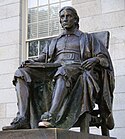John Harvard
 | |
| Data i miejsce urodzenia | 26 listopada 1607 |
|---|---|
| Data i miejsce śmierci | 14 września 1638 |
| Miejsce pochówku | |
| Wyznanie | chrześcijańskie |
| Kościół | Purytański |
John Harvard (ur. 26 listopada 1607 w Londynie, zm. 14 września 1638 w Charlestown[1]) – angielski duchowny purytański, pastor w prowincji Massachusetts Bay. Jego imieniem został nazwany Uniwersytet Harvarda[2].
Londyńczyk z dzielnicy Southwark, czwarty z dziewięciorga dzieci Roberta Harvarda (1562–1625), z zawodu rzeźnika, właściciela tawerny i jego żony, Katherine. Ojciec Katherine Rogers (1584–1635), Thomas Rogers (1540–1611) jest kojarzony z Williamem Shakespeare’em (1564–1616). Rodzina pochodziła bowiem ze Stratford-upon-Avon w Anglii.
Latem 1625 ojciec, siostra przyrodnia i dwaj bracia zmarli zarażeni dżumą (epidemia czarnej śmierci).
W 1632 John Harvard otrzymał dyplom Emmanuel College na Uniwersytecie Cambridge, wówczas uczelni purytańskiej.
Matka, Katherine Harvard, zmarła w 1635, a dwa lata później, wiosną, brat Thomas.
W kwietniu 1636 John poślubił Ann Sadler z Ringmer w hrabstwie Sussex.
W 1637 Harvardowie wyemigrowali do Nowej Anglii i osiedlili się w Charlestown w Massachusetts. Jedna trzecia z pierwszych 100 absolwentów, którzy ukończyli studia w Nowej Anglii, to posiadacze dyplomów z Emmanuel College w Cambridge w Anglii.
John Harvard umarł bezdzietnie 14 września 1638. W testamencie zapisał połowę swojego majątku i bibliotekę (około 400 tomów), college’owi, który właśnie powstał w pobliskim Cambridge[3]. Uczelnia ta została utworzona w dniu 8 września 1636, a imię Harvarda przyjęła w dniu 13 marca 1639. Dopiero Konstytucja Massachusetts z 1780 mówi o tej szkole jako o Uniwersytecie Harvarda, a nie o College’u Harvarda.
Przypisy
- ↑ The Life and Times of John Harvard, johnharvard.us [dostęp 2020-01-09].
- ↑ Alfred G. Brickel, The Founding of Harvard College, „Thought”, 11 (1), 1936, s. 161–165, DOI: 10.5840/thought193611189, ISSN 0040-6457 [dostęp 2020-01-09].
- ↑ Massachusetts Commissioners on Harvard Bridge, Harvard Bridge: Boston to Cambridge, March 1892, Rockwell and Churchill, 1892 [dostęp 2020-01-09] (ang.).
Media użyte na tej stronie
Autor: alainedouard, Licencja: CC BY-SA 3.0
An "idealized" representation of John Harvard, there being nothing to indicate what he had actually looked like.
The inscription below reads
- John Harvard · Founder · 1636
Tour guides tell visitors that statue is also known as "Statue of Three Lies", the three lies being purported to be:
- Lie # 1 : This is not John Harvard's face; no picture or statue of John Harvard survived.
- Lie # 2 : John Harvard was not founder of Harvard University; it was founded two years prior to being renamed Harvard in 1638.
- Lie # 3 : The inscription says that Harvard was founded in 1638; in fact, it was founded two years earlier.
Autor: Jessica Williams, Licencja: CC-BY-SA-3.0
Statue in the college yard of Harvard University, Cambridge, Massachusetts. Known as the "Statue of the three lies" because (1) Harvard was founded in 1636, not 1638 (2) Harvard was an early benefactor, not the founder and (3) the statue is not of Harvard, but of a 19th-century Harvard student.


